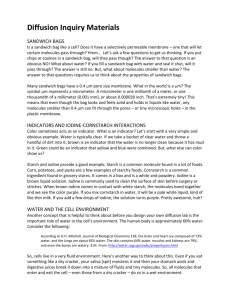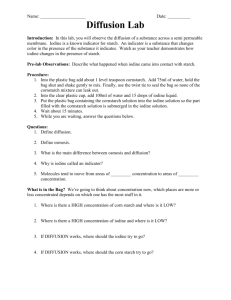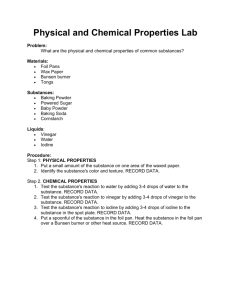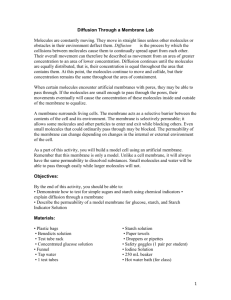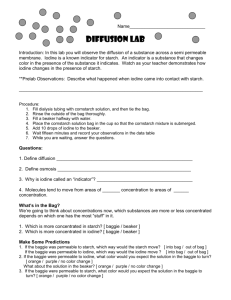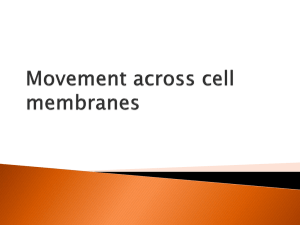Passive Transport Lab
advertisement
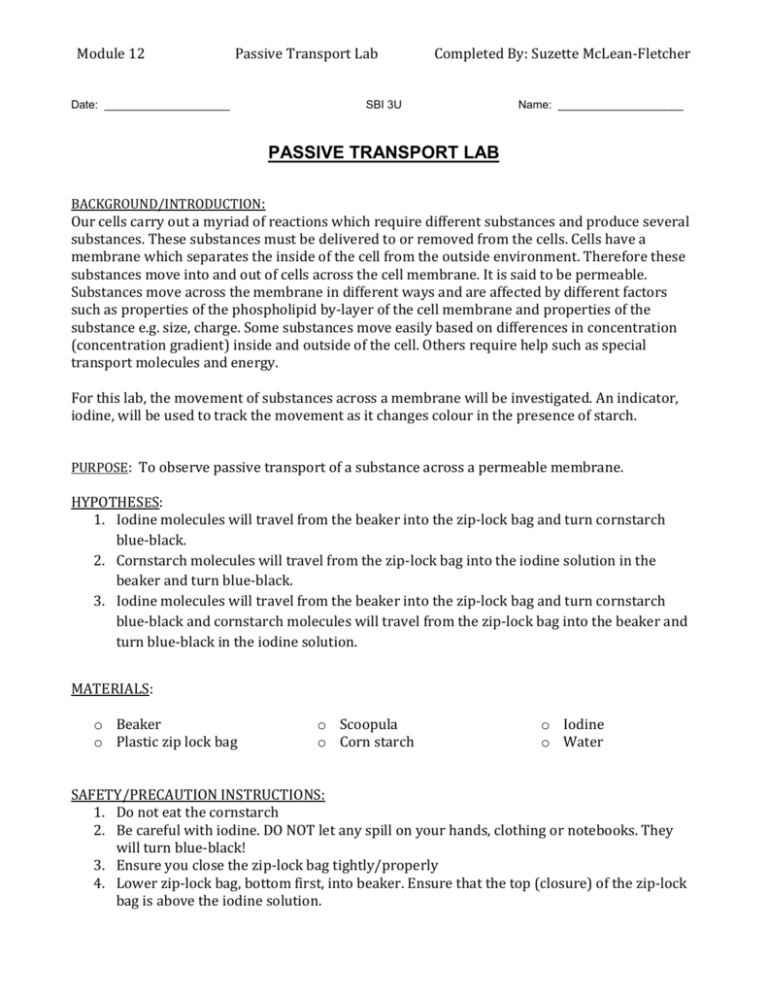
Module 12 Passive Transport Lab Date: ____________________ Completed By: Suzette McLean-Fletcher SBI 3U Name: ____________________ PASSIVE TRANSPORT LAB BACKGROUND/INTRODUCTION: Our cells carry out a myriad of reactions which require different substances and produce several substances. These substances must be delivered to or removed from the cells. Cells have a membrane which separates the inside of the cell from the outside environment. Therefore these substances move into and out of cells across the cell membrane. It is said to be permeable. Substances move across the membrane in different ways and are affected by different factors such as properties of the phospholipid by-layer of the cell membrane and properties of the substance e.g. size, charge. Some substances move easily based on differences in concentration (concentration gradient) inside and outside of the cell. Others require help such as special transport molecules and energy. For this lab, the movement of substances across a membrane will be investigated. An indicator, iodine, will be used to track the movement as it changes colour in the presence of starch. PURPOSE: To observe passive transport of a substance across a permeable membrane. HYPOTHESES: 1. Iodine molecules will travel from the beaker into the zip-lock bag and turn cornstarch blue-black. 2. Cornstarch molecules will travel from the zip-lock bag into the iodine solution in the beaker and turn blue-black. 3. Iodine molecules will travel from the beaker into the zip-lock bag and turn cornstarch blue-black and cornstarch molecules will travel from the zip-lock bag into the beaker and turn blue-black in the iodine solution. MATERIALS: o Beaker o Plastic zip lock bag o Scoopula o Corn starch o Iodine o Water SAFETY/PRECAUTION INSTRUCTIONS: 1. Do not eat the cornstarch 2. Be careful with iodine. DO NOT let any spill on your hands, clothing or notebooks. They will turn blue-black! 3. Ensure you close the zip-lock bag tightly/properly 4. Lower zip-lock bag, bottom first, into beaker. Ensure that the top (closure) of the zip-lock bag is above the iodine solution. Module 12 Passive Transport Lab Completed By: Suzette McLean-Fletcher METHOD: 1. 2. 3. 4. 5. 6. 7. 8. Put 1 scoop of corn starch into the bag. Put 200mL of water into the bag. Close bag. Add water to a beaker until it is half full Put 10 drops of iodine into the beaker. Submerge the bag in the beaker. Wait for 15 minutes. Record observations. OBSERVATIONS: Table showing observations of colour changes before and after zip-lock bag containing cornstarch solution was submerged in a beaker of iodine solution. Condition Cornstarch BEFORE submersion of bag into beaker White suspension/solution Iodine solution Volume of solutions Yellow-brown Beaker was half-full with iodine solution AFTER submersion of bag into beaker Streaks of blue-black colour began forming in the cornstarch solution which became increasingly more blue-black as time passed Yellow-brown Iodine solution decreased and zip-lock bag with cornstarch looked swollen. ANALYSIS: 1. Compare and contrast diffusion and osmosis. Both diffusion and osmosis involve the movement of substances from an area of high concentration to an area of low concentration (down a concentration gradient). They will both occur until an equilibrium is reached at which time there will be no net movement of substances. Diffusion does not require a membrane (whether fully permeable or semi-permeable) to occur and it involves molecules of gases, solids, liquids. Osmosis, on the other hand, involves the movement of water molecules from a region where they are in high concentration (hypotonic solution) to a region where they are in lower concentration (hypertonic solution) across a semipermeable membrane. Module 12 Passive Transport Lab Completed By: Suzette McLean-Fletcher 2. Describe what happened to the iodine. Be sure to use the words “hypertonic”, “hypotonic”, “high concentration”, “low concentration” and “concentration gradient” in your answer. The iodine solution remained yellow-brown after submersion. This means that no cornstarch molecules diffused/moved into the beaker. It also decreased in volume. The iodine solution was hypotonic (had more water molecules) to the cornstarch solution which was hypertonic (less water molecules). Water molecules therefore moved down the concentration gradient from its high concentration in the iodine solution across the zip-lock bag membrane to the cornstarch solution where it was in low concentration. 3. Describe what happened to the starch. Be sure to use the words “hypertonic”, “hypotonic”, “high concentration”, “low concentration” and “concentration gradient” in your answer. The cornstarch solution became blue-black as iodine molecules moved down the concentration gradient into it from their region of high concentration (hypertonic iodine solution) to a low concentration (hypotonic cornstarch solution). The starch molecules did not move as the iodine solution did not change to blue-black. 4. Conclude whether the bag is a permeable or semi-permeable membrane. Support your answer with evidence. The zip-lock bag was a semi-permeable membrane as small molecules of iodine and water were able to move across it but the larger starch molecules could not. This was evidenced by (i) the blue- black colour to which cornstarch changed indicating that iodine diffused into it (ii) the decrease in volume of the iodine solution and the subsequent swollen zip-lock bag indicating that water molecules moved from iodine solution into the cornstarch solution and (iii) the lack of colour change of the iodine solution (did not turn blue-black) indicating that starch molecules did not diffuse into it. 5. Conclude whether diffusion or osmosis occurred in this experiment. Support your answer with evidence. Both diffusion and osmosis occurred in this experiment. Iodine molecules moved by diffusion from its high concentration in the iodine solution to the cornstarch solution where it was in low concentration as evidenced by the blue-black colour change of the cornstarch. Water molecules moved by osmosis across the semi-permeable membrane of the zip-lock bag from the hypotonic iodine solution where they were in high concentration to the hypertonic cornstarch solution where they were in low concentration.
